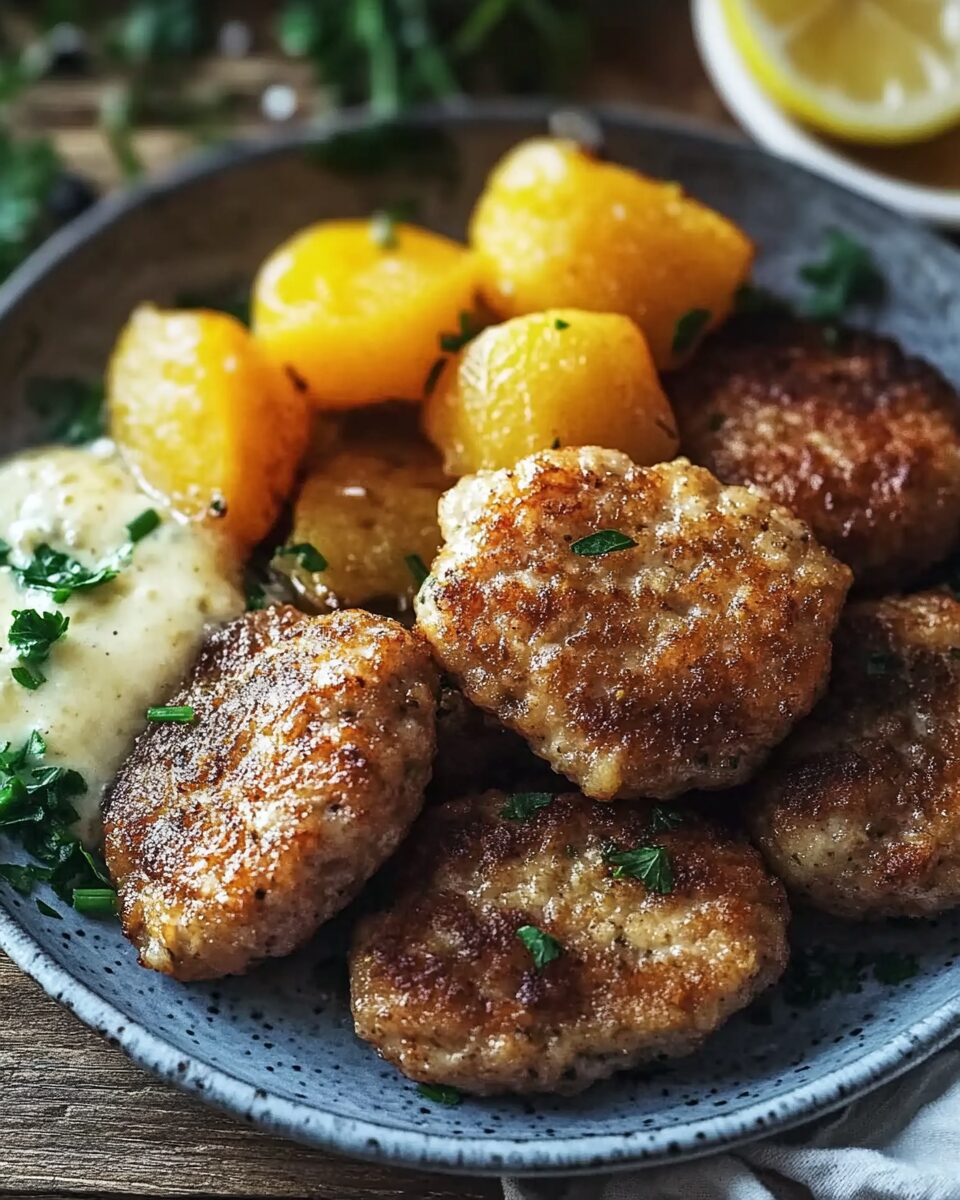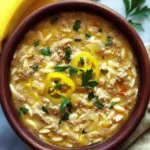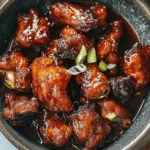The German Frikadellen is a dish deeply rooted in German home-cooking tradition. Often referred to as German meatballs or hamburger-style patties, these savory, pan-fried delights are bursting with flavor. They are crisp on the outside, tender and juicy inside, and seasoned with classic ingredients like mustard, onion, and paprika.
Whether served with creamy mashed potatoes, fresh green salad, or nestled into a crusty bun for a Frikadellen sandwich, this dish is satisfying and versatile. Perfect for a cozy family dinner or a casual weekend lunch, Frikadellen bring that rustic, comforting vibe straight to your plate. Best of all, they’re quick to make and crowd-pleasing every time.
Full Recipe
Ingredients:
-
1 lb (500g) ground beef (or mix of beef and pork)
-
1 small onion, finely chopped
-
1 egg
-
1 slice of day-old bread (or 1/2 cup breadcrumbs)
-
1/4 cup milk
-
1 tbsp mustard (preferably German-style)
-
1 tsp paprika
-
Salt and pepper to taste
-
1 tbsp chopped parsley (optional)
-
2 tbsp oil or butter for frying
Directions:
-
Soak the bread slice in milk until soft, then squeeze out excess liquid and crumble it into a bowl.
-
Add the ground meat, chopped onion, egg, mustard, paprika, parsley, salt, and pepper. Mix everything well with your hands until fully combined.
-
Shape the mixture into round, slightly flattened patties, about the size of your palm.
-
Heat oil or butter in a skillet over medium heat.
-
Fry the patties for 4-5 minutes on each side, or until browned and cooked through.
-
Let rest for a few minutes before serving.
Prep Time: 15 minutes | Cooking Time: 10 minutes | Total Time: 25 minutes
Kcal: 280 kcal | Servings: 4 patties
A Deep Dive into German Frikadellen: Tradition, Taste, and Timeless Appeal
German Frikadellen are more than just meat patties — they are a celebration of heritage, comfort, and simple, wholesome flavors. These savory patties have been a staple of German home cooking for centuries and are often compared to American hamburgers or meatballs. However, Frikadellen have a distinct flavor and texture all their own, born from generations of culinary tradition, regional variations, and a commitment to hearty, satisfying meals. In this article, we’ll explore the cultural significance, origin, serving ideas, variations, nutritional aspects, and why this dish remains beloved both in Germany and across the world.
The Origins of Frikadellen
Frikadellen trace their roots back to Europe’s long-standing love for ground meat dishes. While variations of ground meat patties exist all over the continent — from Italian polpette to Swedish köttbullar — Frikadellen are distinct in their German origin and ingredients. Historically, they were considered a “poor man’s meal,” a clever and efficient way to stretch small amounts of meat with affordable fillers like soaked bread or breadcrumbs. This not only made the dish more accessible but also enhanced its moist and tender texture.
The name “Frikadellen” is believed to derive from the French word fricandeau, referring to a type of finely sliced meat preparation. Through cultural exchange and adaptation, Germany embraced and transformed this into what we know today as Frikadellen — pan-fried patties made from ground meat, seasoned with herbs and spices, and enjoyed by people of all ages.
Cultural Significance in Germany
Frikadellen are a quintessential part of German cuisine and are deeply tied to family meals and traditional gatherings. They are commonly served at local fairs, Oktoberfest events, and casual get-togethers. You’ll find them in every German household, picnic basket, and beer garden. This dish carries nostalgia for many — a symbol of grandma’s kitchen or a hearty weeknight dinner shared with family.
In some regions, Frikadellen are known by other names such as Bulette in Berlin or Fleischpflanzerl in Bavaria, but the essence remains the same. These patties are a symbol of unity in culinary diversity, showcasing how one dish can be interpreted differently across German states while still keeping its soul intact.
How Frikadellen Differ from Hamburgers
Although often likened to hamburgers, Frikadellen have their own unique personality. They are usually shaped thicker and rounder, with a slightly flattened top and bottom. The texture is softer and juicier, thanks to the use of soaked bread or breadcrumbs, which keep the meat moist during cooking.
Another key difference lies in the seasoning. Frikadellen are enhanced with mustard, paprika, onions, parsley, and sometimes even nutmeg — flavors that give them a warm, spiced depth without being overpowering. Unlike hamburgers, they’re not typically served in buns but rather alongside potatoes, vegetables, or fresh salads.
Serving Ideas and Pairings
Frikadellen are incredibly versatile, making them suitable for various meal settings. Traditionally, they’re served hot with creamy mashed potatoes and gravy or cold as part of a picnic spread. They pair beautifully with sauerkraut, potato salad, steamed vegetables, or even in a sandwich with pickles and mustard.
They can be a satisfying main course for dinner, a protein-packed lunchbox addition, or even a grab-and-go snack when served cold. Because of their mild yet flavorful profile, they also appeal to children and picky eaters, making them an excellent family-friendly dish.
To elevate the experience, consider serving Frikadellen with a side of German mustard or a dollop of sour cream. A cold beer or a crisp apple cider complements the savory flavors and adds to the authenticity of the meal.
Regional and Modern Variations
As with many traditional recipes, Frikadellen vary by region and family tradition. In northern Germany, for instance, you might find them seasoned more heavily with herbs, while in Bavaria, the patties may include diced bacon or cheese. Some cooks add grated carrot or zucchini for extra moisture and nutrition, while others experiment with different ground meats like turkey, lamb, or plant-based alternatives.
Modern takes on Frikadellen include gluten-free versions using oat flour instead of breadcrumbs or dairy-free variants made with almond milk. These adaptations make it easy for people with dietary restrictions to enjoy the same comforting dish.
Fusion versions have also emerged, such as Mediterranean Frikadellen with feta and olives or spicy Frikadellen using harissa or jalapeño for a kick. These twists prove that while rooted in tradition, Frikadellen are more than capable of evolving to suit contemporary tastes.
Nutritional Highlights
Frikadellen are a balanced dish, offering a good mix of protein, fats, and carbohydrates. The use of lean ground meat keeps them relatively low in fat, especially when paired with vegetables or a salad. The addition of onions and parsley not only enhances flavor but also adds nutrients like vitamin C and antioxidants.
Depending on portion size and preparation, each patty provides around 250 to 300 calories, making it suitable for both light and hearty meals. Opting to bake instead of fry or using a non-stick skillet can further reduce fat content without sacrificing flavor.
Including soaked bread helps retain moisture but also stretches the meat — a budget-friendly and practical approach to feeding a larger group.
Why Frikadellen Are Still Loved Today
In a world full of fast food and trendy cuisine, Frikadellen hold a special place in many people’s hearts. They are humble, satisfying, and deeply personal — everyone seems to have their own version passed down through generations.
Their enduring popularity lies in their flexibility. You can prep them ahead of time, freeze them for later, and reheat without losing texture or flavor. They work for both casual weekday meals and special occasions, and their universal appeal makes them a reliable go-to in any kitchen.
Frikadellen also encourage hands-on cooking, a sensory experience that connects people to the food they make and eat. From shaping the patties to hearing the sizzle in the pan, it’s a dish that involves love and care in every step.
Conclusion
Frikadellen are a timeless classic of German cuisine — a dish that brings families together, carries cultural pride, and delivers flavor in every bite. Whether you enjoy them hot or cold, traditional or with a twist, these savory meat patties are proof that the simplest recipes often have the deepest roots.
In embracing Frikadellen, you’re not just cooking a meal — you’re participating in a centuries-old tradition that honors resourcefulness, flavor, and connection. Perfect for busy weeknights, festive tables, or meal prepping, Frikadellen deserve a spot in your culinary repertoire.
Their comforting taste, rich history, and incredible adaptability are what keep Frikadellen on the plates — and in the hearts — of so many around the world.






